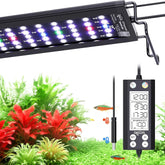The Complete Beginner's Guide to Keeping Fish: Setting Up Your First Aquarium
The Complete Beginner's Guide to Keeping Fish: Setting Up Your First Aquarium
Keeping fish is a rewarding hobby that can beautify your home and provide relaxation. However, for beginners, knowing how to start properly can be challenging. This guide covers all the basics - essential equipment, tank setup, and maintenance tips - to help you avoid common mistakes like "fish dying within days."
Part 1: 3 Must-Know Facts Before Starting
1. Fishkeeping ≠ Just Changing Water
Many assume keeping fish simply requires a tank, some fish, and occasional water changes. In reality, fish have specific requirements for water quality, temperature, and environment that require establishing a stable ecosystem.
2. Best Fish for Beginners
-
Small Tropical Fish: Guppies, Zebra Danios, Neon Tetras (hardy, colorful)
-
Coldwater Fish: Goldfish, Koi (no heater needed but require more space)
-
Not Recommended for Beginners: Arowana, Saltwater Fish (expensive, difficult)
3. Choosing the Right Tank Size
-
Small Fish (3-5cm): 30-50 liter tank (e.g. 40×30×30cm)
-
Medium Fish (~10cm): 60-100 liter tank
-
Golden Rule: 1 liter water per 1cm of fish (e.g. 5 fish at 5cm each need 25+ liters)

Part 2: Essential Equipment Checklist
1. Must-Have Basics
| Equipment | Purpose | Buying Tips |
|---|---|---|
| Aquarium | Fish habitat | Opt for ultra-clear glass tanks |
| Filter | Maintains clean water | Hang-on-back (small tanks) or canister filters (large tanks) |
| Heater (for tropical fish) | Maintains stable temperature | Adjustable (24-28°C) with thermometer |
| Lighting | Supports fish/plant health | LED aquarium light (8-10 hours daily) |
| Substrate | Decoration + beneficial bacteria | Choose 3-5mm gravel, rinse first |
2. Recommended Upgrades
-
Water Test Kit (pH, ammonia, nitrite)
-
Automatic Feeder (for vacations)
-
CO2 System (planted tanks)
-
Wave Maker (improves flow in large tanks)

Part 3: Step-by-Step Tank Setup (Beginner Must-Read!)
1. Equipment Installation
-
Rinse tank (water only - no soap!)
-
Add substrate (3-5cm depth, slope for aesthetics)
-
Install filter & heater (avoid front viewing area)
-
Fill with dechlorinated water (let tap water sit 2 days or use conditioner)
-
Run equipment for 24 hours to check functionality
2. Cycling Your Tank (Most Important Step!)
-
Days 1-3: Add nitrifying bacteria
-
Days 4-7: Add 2-3 "starter fish" (e.g. cheap guppies)
-
Week 2: Test water daily until ammonia/nitrites reach zero
-
Week 3: When stable, add main fish
⚠️ Key Note: Don't change water during cycling! Let the nitrogen cycle establish naturally.
Part 4: Daily Maintenance Tips
1. Feeding
-
Frequency: 1-2 times daily (only what they eat in 2 minutes)
-
Food: Mainly flakes/pellets, occasional frozen bloodworms (live food may carry diseases)
-
Rule: Underfeed rather than overfeed! Excess food pollutes water.
2. Water Changes
-
Frequency: 25-33% weekly
-
Method: Use a gravel vacuum to remove waste
-
Temperature: Match new water to tank temp (±1°C)
3. Cleaning
-
Filter Media: Rinse monthly in tank water (never tap water)
-
Algae: Use magnetic scrubber or algae scraper

Part 5: Common Problems & Solutions
1. Cloudy Water?
-
Cause: Unestablished cycle or overfeeding
-
Fix: Reduce feeding, add bacteria, improve filtration
2. Sick Fish?
-
White Spots (Ich): Raise temp to 30°C for 3 days
-
Fin Rot: Improve water quality, use aquarium salt/medication
-
Gasping at Surface: Increase aeration, test for ammonia
3. Algae Bloom?
-
Reduce light (≤8 hours daily)
-
Add cleaners (Otocinclus catfish, Amano shrimp)
Part 6: Final Tips
-
Cycle before adding fish - stable water is key!
-
Start with hardy species like guppies or danios
-
Weekly water changes prevent problems
-
Don't panic if issues arise - test water first
Fishkeeping requires patience, but with proper care, you'll create a thriving underwater world! Have questions? Ask in the comments! 🐠💦






1 コメント